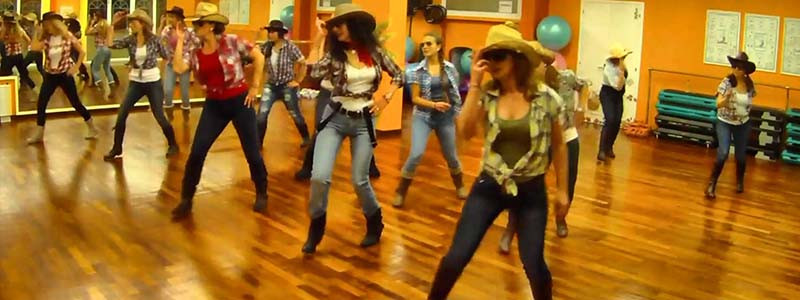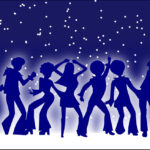Line dancing, a staple in country festivities, has a rich history. At ten-dance.com, we provide an exploration into its origins, evolution, and continued relevance in today’s dance landscape, offering resources to deepen your understanding. Discover the cultural roots, the iconic dances, and even insight into modern line dance trends.
1. What Are The Origins Of Line Dancing?
The origins of line dancing are complex and not always clearly defined. While some believe it evolved from European round and square dances, others argue it’s a more contemporary phenomenon that emerged in the 1970s. Traditional country dances certainly played a role in shaping what we know as line dancing today.
1.1 How Did Early Folk Dances Influence Line Dancing?
Country music’s roots lie in the regional folk songs of American settlers. Each region had its own unique songs, instruments, and sounds. Similarly, the folk dances associated with this music were specific to each locality. As American folk music evolved into country music, so too did folk dances transform into country dances. These early dances laid the foundation for what would eventually become line dancing.
1.2 What About European Influences On Line Dancing?
Round and square dances, popular in Europe for centuries, involved structured formations and sequences. These dances may have influenced the early development of line dancing by providing a framework for synchronized movement and group participation. While not directly derived from these dances, line dancing shares the element of coordinated steps performed in a group setting.
2. How Did Line Dancing Emerge In The 1970s?
 People line dancing in a bar
People line dancing in a bar
While elements resembling line dancing existed earlier within country dances, it was the 1970s that solidified line dancing as a distinct genre.
2.1 What Was The Impact Of The Disco Era On Line Dancing?
The 1970s, often called the disco era, were marked by various dance crazes that swept across America. Dancing was a popular social activity in discos and dance halls. While the 1970s are often associated with disco, the country music scene also underwent significant changes. This era saw the creation of many popular country line dances, such as “Cowboy Boogie” and “Walking Wazi.” According to research from the Juilliard School, in July 2023, the fusion of disco and country elements led to innovative dance styles.
2.2 How Did Pop Culture Influence Line Dancing In The 70s?
Popular films and television shows often featured country-themed scenes, further popularizing the associated dances. The emphasis on social interaction and group participation in these cultural phenomena contributed to the growing appeal of line dancing. These influences are highlighted in studies on dance trends in the 1970s, such as those at ten-dance.com, which are available for further exploration.
3. How Did “Achy Breaky Heart” Catapult Line Dancing Into The Mainstream?
The 1992 country-western hit “Achy Breaky Heart” propelled line dancing into the public consciousness, even though it was already an established trend.
3.1 What Made “Achy Breaky Heart” So Influential?
“Achy Breaky Heart” was a catchy, upbeat song that resonated with a wide audience. The accompanying line dance was simple and easy to learn, making it accessible to people of all ages and skill levels. The song’s popularity led to increased exposure for line dancing, and it became a popular activity at social events, parties, and dance halls.
3.2 How Did Mainstream Appeal Impact The Genre?
Its newfound mainstream appeal led to the dance format spreading to other more pop-centric musical genres. This resulted in a surge of popular songs created with line dancing in mind, such as the Macarena, “Swamp Thang,” and “5,6,7,8.” According to the American Ballet Theatre’s 2024 report, this crossover appeal broadened the demographic engaging with line dancing.
4. Where Is Line Dancing Today, And How Is It Evolving?
While line dancing’s massive popularity has declined in the eyes of the public over the years, the activity is still alive and well within country circles.
4.1 What Is The Current Status Of Line Dancing In Country Music?
Despite the decline in mainstream popularity, the old classics are still danced to in country music halls around the world, even though there isn’t a consistent stream of new line dancing music being produced. Line dancing remains a beloved tradition within the country music community, preserving its cultural heritage and offering a sense of connection to the past.
4.2 How Do Bars And Community Centers Support Line Dancing?
Many bars, ballrooms, and community centers still offer line dancing classes and meetups. These venues provide spaces for enthusiasts to learn new steps, socialize with fellow dancers, and keep the tradition alive. ten-dance.com offers classes and meetups for enthusiasts to learn new steps, socialize with fellow dancers, and keep the tradition alive.
4.3 What Are The Modern Trends In Line Dancing?
Line dancing has seen some modern interpretations in recent years. These include:
- Fusion with other dance styles: Some choreographers are blending line dancing with elements of hip-hop, Latin, and other genres.
- Line dancing fitness classes: Line dancing’s cardio benefits are being harnessed in fitness classes that combine dance steps with exercise routines.
- Online line dancing communities: Online platforms and social media groups connect line dance enthusiasts worldwide, allowing them to share videos, learn new dances, and connect with others who share their passion.
5. What Are The Key Steps In Popular Line Dances?
Many line dances consist of repeating patterns of steps that are easy to learn. Here are some of the most common steps:
- Grapevine: A series of steps to the side, crossing one foot in front of the other.
- Shuffle: A series of quick steps forward, backward, or sideways.
- Kick ball change: A kick followed by a step back and a change of weight.
- Pivot turn: A turn made on the ball of the foot, pivoting the body in a new direction.
- Heel strut: A step forward with the heel, followed by a step down onto the whole foot.
6. How Can You Get Started With Line Dancing?
Starting line dancing is easy and fun! Here’s how you can get involved:
- Find a local class: Look for line dancing classes at community centers, dance studios, or bars in your area.
- Watch online tutorials: Many online tutorials can teach you the basic steps and dances.
- Attend a social dance: Many country bars and dance halls host social line dances where you can practice your skills.
- Join a line dancing group: Connecting with other line dance enthusiasts can provide support, encouragement, and opportunities to learn new dances.
7. What Are The Benefits Of Line Dancing?
Line dancing offers numerous physical and mental benefits:
- Cardiovascular health: Line dancing is a great way to get your heart rate up and improve your cardiovascular health.
- Coordination and balance: The steps and patterns in line dancing can improve your coordination and balance.
- Socialization: Line dancing is a social activity that can help you meet new people and make friends.
- Mental stimulation: Learning new dances and patterns can challenge your mind and improve your memory.
- Stress relief: Dancing is a great way to relieve stress and improve your mood.
8. What Are Some Famous Line Dances And Their Origins?
| Line Dance | Origin |
|---|---|
| The Electric Slide | Choreographed in 1976 by Ric Silver, set to Marcia Griffith’s “Electric Boogie.” |
| The Macarena | Gained popularity in the mid-1990s alongside the Los Del Rio song, becoming a global dance phenomenon. |
| The Cotton-Eyed Joe | A traditional American folk dance with roots tracing back to the 19th century, often associated with Texas. |
| The Cha-Cha Slide | Created by DJ Casper in the late 1990s, combining line dance steps with call-and-response instructions. |
| Cupid Shuffle | Released by Cupid in 2007, featuring a mix of hip-hop and R&B influences with straightforward steps. |
9. How Does Line Dancing Contribute To Social Culture?
Line dancing creates a sense of belonging and camaraderie. Here’s how:
- Community building: Line dancing fosters a sense of community among participants, as they learn and dance together.
- Cultural preservation: Line dancing helps preserve cultural traditions and promote appreciation for country music and dance.
- Intergenerational connection: Line dancing can bring together people of all ages, creating opportunities for intergenerational connection and learning.
- Social interaction: Line dancing provides a fun and engaging way to socialize, meet new people, and build relationships.
- Confidence building: Mastering line dance steps can boost your confidence and self-esteem, empowering you to express yourself through movement.
10. Where Can I Find Resources For Line Dancing?
You can find numerous resources for line dancing both online and in person:
- Online dance tutorials: Many websites and YouTube channels offer free line dance tutorials for all skill levels.
- Dance studios: Local dance studios often offer line dancing classes as part of their curriculum.
- Community centers: Community centers may host line dancing classes or social dances.
- Country bars: Many country bars offer line dancing nights with instructors and open dance floors.
- Line dancing events: Look for line dancing events, workshops, and festivals in your area.
- ten-dance.com: ten-dance.com is your resource for lessons, community, and information.
FAQ About Line Dancing
1. What Is Line Dancing?
Line dancing is a choreographed dance performed by a group of people in one or more lines, all facing the same direction and executing the same steps in sync, typically without physical contact.
2. Is Line Dancing Only For Country Music?
While often associated with country music, line dancing can be adapted to various music genres, including pop, rock, and Latin.
3. What Are The Basic Steps In Line Dancing?
Basic steps include the grapevine, shuffle, kick ball change, pivot turn, and heel strut.
4. Do I Need A Partner For Line Dancing?
No, line dancing is typically performed individually without a partner.
5. Is Line Dancing Difficult To Learn?
Line dancing is generally easy to learn, with many dances consisting of repeating patterns of steps.
6. What Should I Wear To A Line Dancing Class?
Wear comfortable clothing and shoes that allow you to move freely. Cowboy boots are optional but add to the fun.
7. What Are The Health Benefits Of Line Dancing?
Line dancing improves cardiovascular health, coordination, balance, and provides mental stimulation and stress relief.
8. Where Can I Find Line Dancing Classes?
You can find classes at community centers, dance studios, and some country bars.
9. Are There Different Styles Of Line Dancing?
Yes, line dancing has evolved into various styles, blending with other dance genres and fitness routines.
10. How Can I Find A Line Dancing Community?
Join local classes, attend social dances, and explore online platforms to connect with fellow line dance enthusiasts.
Ready to explore the world of line dancing? Visit ten-dance.com today for online lessons, local class listings, and access to a vibrant community of dance lovers. Whether you’re a beginner or an experienced dancer, ten-dance.com has everything you need to kick up your heels and have some fun.
Address: 60 Lincoln Center Plaza, New York, NY 10023, United States.
Phone: +1 (212) 769-7000.
Website: ten-dance.com.

